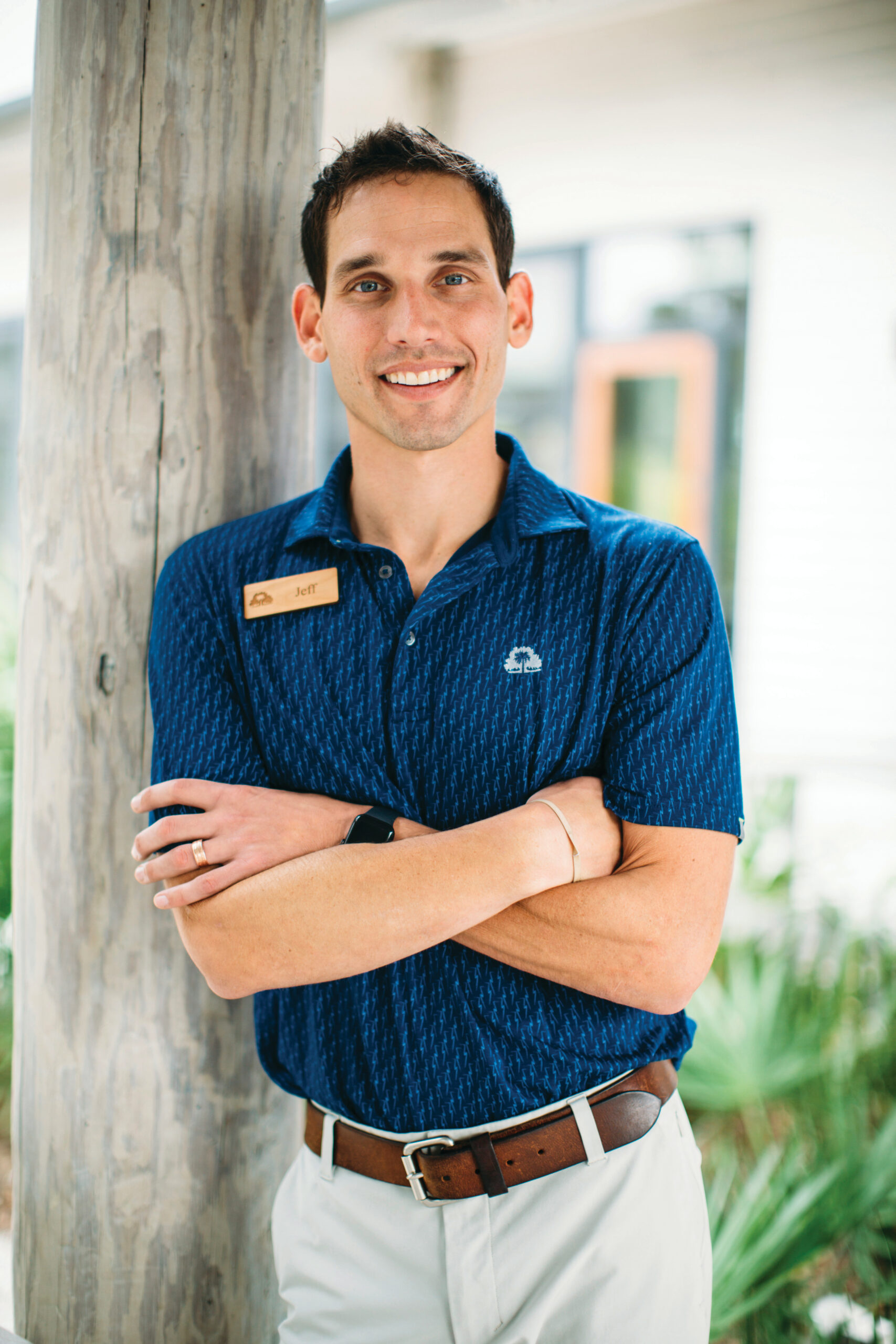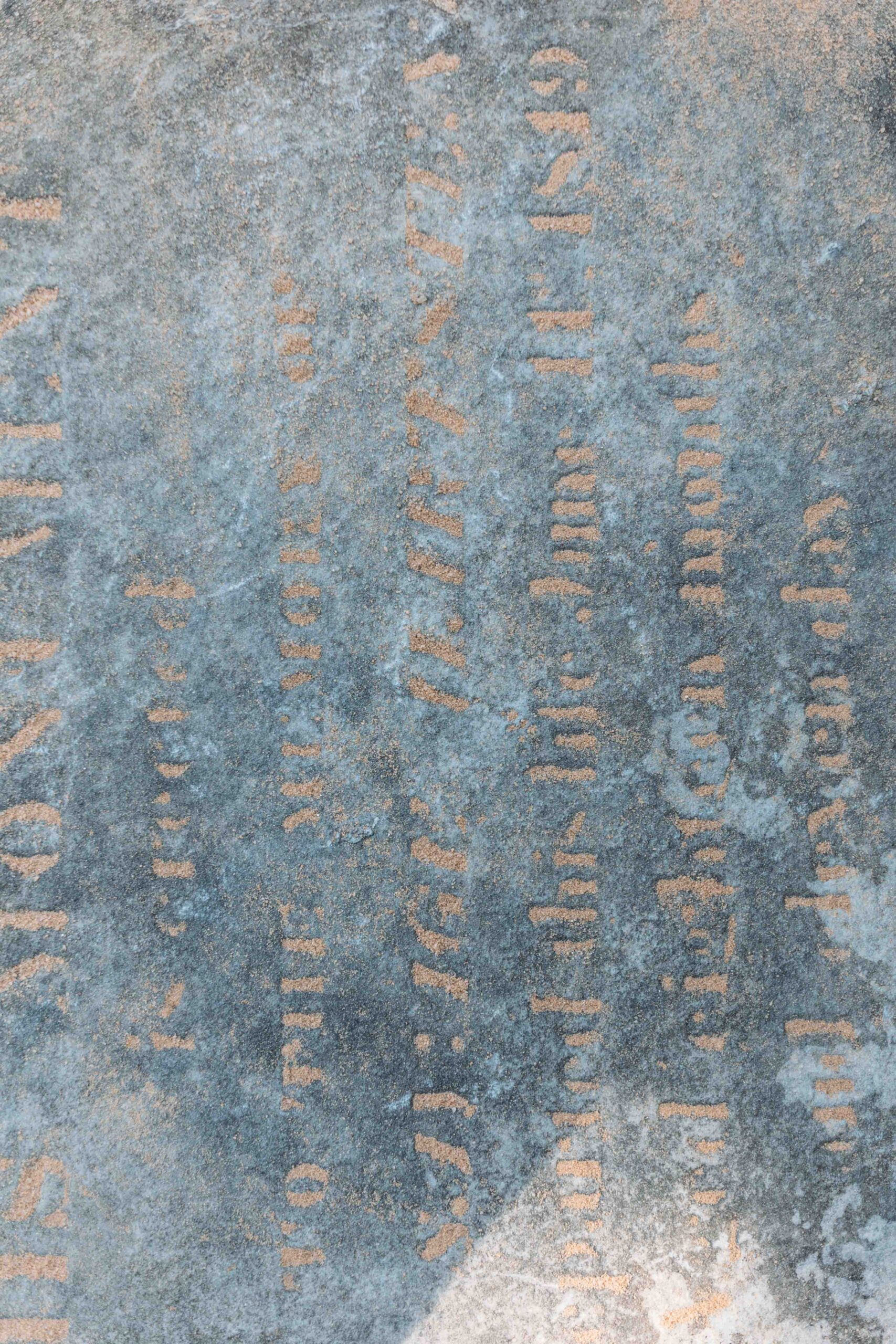Katherine Sandoz takes a step back to admire her site-specific painting at Telfair Museums’ Jepson Center in downtown Savannah, paintbrush still in hand. For a moment, she blends into the afternoon crowd of spectators. There’s a softness about her as she listens to onlookers describe the depth she has offered to this blank canvas. She listens intently, nodding and taking in their thoughts, but offers no further explanation.
It’s symbolic of her general approach to art. Her work is the jumping-off point for conversations about our environment, both natural and man-made.
It’s meant to be personal. The muted strokes of blue, green, and yellow on the wall shift the scale relationship between the viewer and the art presented. And Sandoz is inspired by it all.
Cultivating Growth
Sandoz (pronounced SAHN-doe) is a prolific painter. Her collaboration with Telfair Museums is a culmination of a yearlong study of botanicals. Flora, paint, and artifice intermingle on the canvases she creates. There’s a similar approach to all of her work. Whether it’s fibers, illustrations, or large-scale painting, Sandoz presents her world with active colors and adds an element of surprise. She presses into each portion of her paintings, adding layers and textures to what appears to be a thoroughly finished panel. In turn, she awakens her subject and adds to its story.
In the end, though, she simply wants it to be visually pleasing.
“Before I even have a blank canvas, I have a source of information,” Sandoz says. “There is someone or something in my mind, in my drawings and sketches. I plan for a series in a pretty formal way.”
Sandoz draws inspiration from the world around her. The botanicals often come from long walks in her Vernonburg neighborhood on Savannah’s Southside. This particular painting titled Sagittaria (the formal Latin genus of the katniss plant) explores the relationship between the aquatic plant and its habitation buried in swamps, bogs, and ditches.
Sandoz creates cohesion with each series, embracing the formalism that comes with her techniques—something she has learned to appreciate about herself.
“It’s okay to be a formalist,” she reassures. “Even those who are naïve or untrained have empirical evidence for why they create. They’re not working in a void. We’re all working with what we are given; the lives that have happened before.”
Sandoz’s peppered past has led her to this moment. Her parents met in art school, and she was born in New Hampshire a short time later. “Many children and many stories ensued,” she says, glossing over her early years. Sandoz prefers to live in the present, but her past is represented in the lines of her work. There’s a historical imprint in everything she creates, she says.
She moved often with her mother in her youth, helping families set up homeschools across the US. She herself was homeschooled until eighth grade, and art was always in the background.
“I always made art, just like all kids do,” she says. “People are meant to make things. And if you make things, you are an artist.”
Her implied status seems simple, but art remained a part of her life as she explored other opportunities. After college, she spent a decade in the Army Reserves—she thought it was a good job. In the late ’80s, she caught the advertising bug and embraced office life. She worked as an account planner, collected data for focus groups, and illustrated advertorials.
“Working there, I really became excited by and enamored by the strategies that advertising used to make messages,” she says.
For Sandoz, her scope of work is bound by similar language. Making qualitative and quantitative studies was something that she could build off of artistically. The tools are the same, she says, but the conclusion is often different.
She left the advertising business to pursue a degree in art. Her intention was to go art school and come back, perhaps become an art director. But like art often does, the outcome shifted during the process.
Blooming Onto The Scene
A small breeze wakes the leaves on a large oak tree outside her home. There used to be more, she says, but in 2016, Hurricane Matthew left a path of destruction. They lost eight trees, one of which fell onto her home. Sandoz, her husband, Dan, and their two sons were displaced for more than a year.
They are finally settling back in, reclaiming their lives and the 1.6 acres they call home. For Sandoz, this remains her sanctuary. The dichotomy of being close to a city and still maintaining the solace of the country has been the perfect compromise for her family. Her husband, an environmental scientist, often goes fishing in the Vernon River, and Sandoz walks through the neighborhood to breathe in the scenery.
A large barn behind the property acts as a makeshift studio. She wakes each morning with a thoughtful intention to paint. The openness of the structure allows her to work on numerous large-scale paintings at once. Sandoz makes a conscious choice to be an artist. It’s a job that needs to be fulfilled, she says.
“Most people are artists naturally, but the art world complicates being an artist. It fetishizes it and puts it on a pedestal,” she says. “The day-to-day is not always simple, but if you have a need to create, you will do it.”
Sandoz drew on this comparison as she reminisced about being both a student and educator at Savannah College of Art and Design (SCAD). While studying for her master of fine arts in illustration, she never felt obligated to finish a project; it was something she simply did. Likewise, in her years as a professor of illustration, she steered students to develop their own voice and work within their own parameters and self-imposed constraints.
“They were going to create with or without me,” she says. “When you’re an artist, you have to.”
Sandoz is at home in Savannah. It’s where her philanthropic efforts are centered. It’s where her sons attend school and where she offers an intern program for SCAD and Georgia Southern University students. Savannah is where Rachel Reese, Telfair Museums’ curator of modern and contemporary art, first reached out with the possibility of a creative pursuit.
Reese asked Sandoz to consider making a site-specific painting and further explore the layers, translucency, and transparency to transcribe it into an additional installation piece.
Sandoz found her interests all came together while creating Sagittaria and its complementary sculptured installation piece Katniss, but she had reservations early on. She had never before made a sculpture. Even still, the sculpture evolved in the same manner as the native vegetation that inspired its arrangement. It grew slowly from an idea—a seedling—into something more tangible. She soon partnered with fellow SCAD alum Julio Garcia of Price Street Projects out of Miami who fabricated the pieces, and she displayed them in the Jepson Center’s atrium with the help of museum staff. The process took more than a year to develop and resulted in the museum’s largest commission to date for any living artist.
The petal-like shapes are suspended as unique, layered, and translucently colorful acrylic elements, an auspicious 108 pieces in all, and hung from
19 points in the ceiling. The installation transforms as visitors shift location below. Once inside, the building acts as a pond: the sculptures, the leaves, and the viewers become a small but active part of the ecosystem—as a frog, a water bug, or a single-celled organism.
With her latest work, Sandoz asks the audience to ponder how plants and humans are alike and different. She winds viewers along a thoughtfully laid-out path that highlights artistic beginnings and the nature that surrounds us. She places those observing inside the piece, its reflections changing with the times. And once you’re there, all you can do is look up.
%GALLERY%
Photography by: Molly Hayden

Marie McConnell Director of Member relations, Palmetto Bluff Club Where are you from and how did you get here? I am from Buffalo, New York—born and raised. Go Bills! My husband and I got married at Sea Pines in Hilton Head in 2012 and fell in love with the ...

Nestled amidst the tranquility of Palmetto Bluff, Longfield Stables stands as a beacon of serenity amid lush green pastures and the gentle presence of grazing horses. Its picturesque setting makes it a haven not only for the esteemed Palmetto Bluff Club Member...

The Conservancy is looking forward to another summer of fun with our upcoming kid's programs! Wild Child Camp and Junior Naturalist Camp will have dedicated weeks in June. Registration is $200 per child for the week. To participate, parents must fill out t...

Photographs by Summer Pagatpatan Palmetto Bluff is a wilderness playground for families, a gateway to the outdoors, to living life close to nature. Palmetto Bluff Growing Outdoors, or PBGO, encompasses the ethos of this extraordinary place. CampGO is PBGO’...

Discover the May River and Crossroads Golf Courses at Palmetto Bluff Positioned within the enchanting Lowcountry landscape, Palmetto Bluff boasts an array of world-class amenities, with its golf courses standing as a testament to the community's commitment to...

Jeff’s Journey to the Palmetto Bluff Fitness and Wellness Team Palmetto Bluff is located amidst the serene landscapes of the Lowcountry, a tranquil haven where wellness intertwines seamlessly with nature's splendor. Jeff Ford, the Palmetto Bluff Club's Direct...

5 Benefits of Living in South Carolina Known for its charming small towns, pristine coastline, and natural beauty, the South Carolina Lowcountry is one of the most popular places to live. The Lowcountry is a unique and desirable place to live, offering an arr...

Photographs by Patrick O’Brien Words by Rob Collins Designer Rob Collins of King-Collins offers a first look at Crossroads, Palmetto Bluff’s new nine-hole reversible golf course. It is a feat of design. One routing, The Hammer, is a whirlwind of angles and u...

Story by Katie Epps Photographs by Joel Caldwell Beneath Palmetto Bluff’s sprawling oaks lie twelve cemeteries that serve as the final resting places for hundreds of people and nine dogs. Five of these cemeteries were started as burial grounds for enslaved...

Putting Down Strong Roots The Grove seamlessly combines curated style with courtyard living, welcoming the lush beauty of the Lowcountry at every doorstep. With twelve homesites meticulously designed to maximize outdoor living, Palmetto Bluff Builders offer...

Learn about the Palmetto Bluff Conservancy and how we keep the vision of our land in place.
On land or water, there is an ever-evolving variety of activities.
We do not attempt to independently verify the currency, completeness, accuracy or authenticity of the data contained herein. All area measurements and calculations are approximate and should be independently verified. Data may be subject to transcription and transmission errors. Accordingly, the data is provided on an “as is” “as available” basis only and may not reflect all real estate activity in the market”. © [2023] REsides, Inc. All rights reserved. Certain information contained herein is derived from information, which is the licensed property of, and copyrighted by, REsides, Inc.